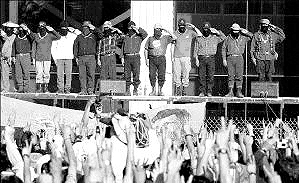
Massive Rally Caps March
by Diego Cevallos
 |
by Diego Cevallos |
|
 (IPS) MEXICO CITY --
The
Zapatista guerrillas reached the Mexican capitol March 11, redoubling pressure for recognition of Native rights.
(IPS) MEXICO CITY --
The
Zapatista guerrillas reached the Mexican capitol March 11, redoubling pressure for recognition of Native rights.
Headed by Subcomandante Marcos, a mestizo (mixed-race) who covers his face with a ski mask, the Zapatista National Liberation Army (EZLN) is today the beacon of Native struggles around the world and has taken aim against the neo-liberal economic model, says Noam Chomsky, a renowned linguist, activist and social researcher from the United States. Similar opinions were heard from such famous authors as the Nobel Prize-winner Jose Saramago of Portugal and Manual Vazquez Montalban of Spain, who were in Mexico City to witness the arrival of the 24 EZLN commanders in the capitol's central plaza. Also supporting that outlook in Mexico City were social scientist Alain Touraine, rights activist Danielle Mitterrand, and peasant leader Jose Bove -- all from France -- as well as Spanish singers Miguel R’os and Joaquin Sabina. There is no doubt that the Zapatistas are currently at the peak of their fame, stated Mexican political analyst Alfonso Zarate, alluding to the 15-day, 12-state motorized "march" the rebel commanders initiated in their home state of Chiapas. The leadership of the EZLN made a triumphant entrance late Sunday afternoon to the Mexican capital's central plaza, the Zocalo, home to the government palace. There, in a ceremony before more than 100,000 people, the commanders declared that the moment has come to recognize the rights of all Native peoples. The audience listened to speeches by four Native commanders and Marcos, who explained that their fight is to conquer a worthy social space for Mexico's native peoples, the poor and the marginalized. The high point was when Marcos spoke. As always, he was dressed in his traditional black and tan rebel's uniform with munitions belts across his chest, a canteen on his belt and an intercom headset over his ski mask. "It is the hour of the Indian peoples who are the color of the earth, of all the colors that we are underneath, and the colors that we are in spite of the color of money," stated the guerrilla leader, in the poetic tone that has characterized his recent speeches.
|
|
 The
event is considered historic because of the massive turnout and the symbolic meaning behind the occupation of the main plaza, the same square the revolutionary armies of Emiliano Zapata (the EZLN's namesake) and Pancho Villa took over in 1914.
The
event is considered historic because of the massive turnout and the symbolic meaning behind the occupation of the main plaza, the same square the revolutionary armies of Emiliano Zapata (the EZLN's namesake) and Pancho Villa took over in 1914.
Nevertheless, the mobilization paled in comparison with the actions of other organizations that are fighting for Native rights in Latin America, a region that is home to an estimated 45 million Native peoples. In Ecuador, for example, a Native uprising in January 2000 led to the removal of then-president Jamil Mahuad. The Ecuadorian native organizations are considered the most powerful in Latin America. In other countries, such as Bolivia and Peru, Native groups -- headed by leaders of Native origin -- in recent years have won posts in parliament, and in others, like Chile and Brazil, they have successfully halted or modified infrastructure development projects that would have harmed their ancestral lands and the environment. But Mexico's Native peoples have yet to make headway in politics. They make up 10 percent of the population -- out of Mexico's 100 million -- but do not hold even one percent of public posts, according to official data. Mexico is the Latin American country with the largest native population -- 10 million -- but they are proportionally fewer than those of Bolivia, Guatemala, Ecuador or Peru. With a rebel army lacking in weapons and resources, the EZLN burst onto the scene Jan. 1, 1994. At first, the guerrillas' discourse was not entirely focused on Native matters, but as the years passed and their fame grew, indigenous rights became the key to their existence. Thanks to Marcos's stage presence, his international contacts, political initiatives and unconventional leftist rhetoric, the EZLN has remained an important actor in the scenario of indigenous struggles worldwide. The international image and the demands of the Zapatistas have also received a boost from the geopolitical importance of Mexico itself. But like other Latin American countries, where most indigenous communities are poor, in Mexico this social group suffers the worst levels of marginalization. The EZLN, like all of the region's Native organizations, is demanding that the government and lawmakers take action to ensure respect for their cultural identities, greater development for their communities and an end to racism. The Mexican rebels, however, with just 12 days of battle in early 1994, achieved more fame than others, and today serve as a reference point in the struggle of those who oppose economic globalization and the worldwide implementation of the neo-liberal model. The Natives' demands for autonomy have been loud enough that the United Nations has been studying -- for more than a decade -- an international declaration on Native people's rights. But in that forum, as it is within numerous countries, especially Latin American nations, government and corporate pressures are blocking recognition of Native rights as those in power fear they would divide the state and that indigenous peoples would be outside the scope of the globalization process.
Albion Monitor
March 19, 2001 (http://www.monitor.net/monitor) All Rights Reserved. Contact rights@monitor.net for permission to use in any format. |